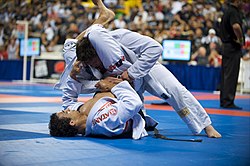
Back جيو جيتسو برازيلية Arabic Jiu-jitsu brasilanu AST Braziliya ciu-citsusu Azerbaijani Бразилско жиу-жицу Bulgarian ব্রাজিলীয় জিউ-জিৎসু Bengali/Bangla Jiu-jitsu brazilian Breton Jujutsu brasiler Catalan جیو جیتسوی بەڕازیلی CKB Brazilské jiu-jitsu Czech Brasiliansk jiu-jitsu Danish
 Romulo Barral attempting a triangle choke on Gabriel Vella at the 2009 World Jiu-Jitsu Championship | |
| Also known as | BJJ, Gracie jiu-jitsu, gi jiu-jitsu, no-gi jiu-jitsu, submission grappling Portuguese name: Jiu-jitsu brasileiro Japanese name: Burajirian jūjutsu (ブラジリアン柔術) |
|---|---|
| Focus | Ground fighting, grappling |
| Hardness | Full contact |
| Country of origin | Brazil, Japan |
| Creator | Mataemon Tanabe, Senjuro Kataoka, Taro Miyake, Yukio Tani, Sada Miyako, Geo Omori, Mitsuyo Maeda, Takeo Yano, Soshihiro Satake, Tokugoro Ito, Jacintho Ferro,[1] Donato Pires dos Reis,[1] Hélio Gracie, Carlos Gracie, George Gracie, Oswaldo Gracie, Luiz França,[2] Oswaldo Fadda |
| Famous practitioners | See full list |
| Parenthood | Kodokan Judo, Jujutsu, Catch wrestling |
| Descendant arts | Submission wrestling, 10th planet jiu-jitsu |
Brazilian jiu-jitsu (Portuguese: jiu-jitsu brasileiro [ʒiw ˈʒitsu bɾaziˈlejɾu, ʒu -]), often abbreviated to BJJ, is a self-defense system, martial art, and combat sport based on grappling, ground fighting, and submission holds. It is primarily a ground-based fighting style and focuses on taking one's opponent down to the ground, gaining a dominant position, and using a number of techniques to force them into submission via joint locks, chokeholds, or compression locks. It has its roots in Ju Jitsu, Judo and Catch Wrestling.
Brazilian jiu-jitsu was first developed around 1925 by Brazilian brothers Carlos, Oswaldo, Gastão Jr., and Hélio Gracie, after Carlos was taught Kodokan judo and Catch Wrestling by a travelling Japanese judoka, Mitsuyo Maeda, in 1917. Later on the Gracie family developed their own self-defense system which they named Gracie Jiu-Jitsu. BJJ eventually came to be its own defined combat sport through the innovations, practices, and adaptation of Gracie jiu-jitsu and judo, and has become one of the essential martial arts for modern MMA.
BJJ revolves around the concept that a smaller, weaker person can successfully defend themselves against a bigger, stronger opponent by using leverage and weight distribution, taking the fight to the ground and using a number of holds and submissions to defeat them. Sparring, commonly referred to as "rolling" within the BJJ community, and live drilling plays a major role in the practitioner's development. In contrast to some other martial arts BJJ can be practiced both using a gi uniform or not which is known as 'no-gi BJJ', for this purpose rash guards are used. BJJ can also be used as a method of promoting physical fitness, building character, and as a way of life.[3][4]
- ^ a b "Who was Oscar Gracie and who taught him jiu-jitsu". Global-training-report.com. Archived from the original on 15 February 2018. Retrieved 5 March 2019.
- ^ "Luiz Franca". bjjheroes.com. Retrieved 5 March 2019.
- ^ Virgílio, Stanlei (2002). Conde Koma – O invencível yondan da história (in Portuguese). Editora Átomo. pp. 22–25. ISBN 85-87585-24-X.
- ^ For more on this, see judo and Kano Jigoro.
© MMXXIII Rich X Search. We shall prevail. All rights reserved. Rich X Search